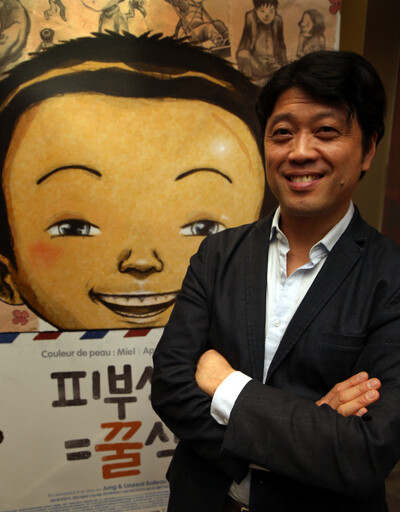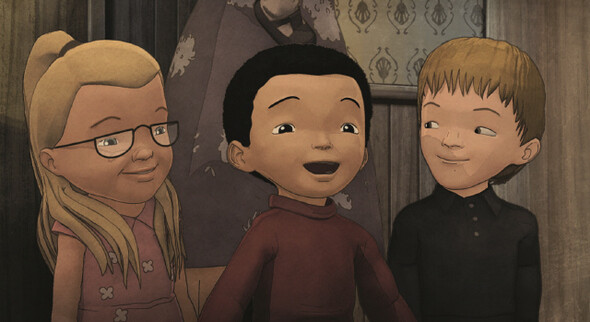hankyoreh
Links to other country sites 다른 나라 사이트 링크
Animator comes to find his roots, years after being “Approved for Adoption”

By Yu Sun-hui, staff reporter
“Korean name: Jun Jung-sik. Affectionate, skinny. Enjoys eating. Tractable, kind, and adorable. A black and bluish scar between his nose and eyes. Approved for adoption. Skin color: honey.”
This was the note that accompanied comic artist and film director Jun Jung-sik (49, Jung Henin) when he was sent to Belgium for adoption at the age of five. After growing up on in a foreign country as an adoptee and coping with the pain of being abandoned, Jung returned to South Korea to promote his auto-biographical animation “Approved for Adoption” (In French, “Couleur de peau : Miel”, 2012).The movie will open in theaters in South Korea on May 8.
The film is an adaptation of a comic of the same name that was published in 2008. Winning major awards at the Annecy International Animated Film Festival in 2012 and the Zagreb Film Festival the following year, the film has been praised for having an appeal that transcends national and linguistic boundaries. Jung met a Hankyoreh reporter for an interview in the Sogong neighborhood of Seoul on Apr. 29.
“Here in Korea, I would like you to call me Jun Jung-sik instead of Jung,” the comic artist said at the beginning of the conversation. He first returned to South Korea in 2010 in order to make the film; this is his third visit to the country. Each time that he visits, he said, he likes Korea a little more.
“It’s kind of like falling in love,” Jung said. “I guess you could say that the first time we met, it was a new experience; the second time, I felt affection; and the third time, it seems like a deeper emotion is coming over me.”

Jung explained that his life has been marked by insecurity about being uprooted, emotional pain caused by his abandonment, and uncertainty about his identity. As is common with other adoptees, he misbehaved frequently, and his adopted mother scolded him harshly for being a “rotten apple.”
“The only reason that I didn’t use drugs, feel the urge to commit suicide, or get depressed like other adopted children was because of comics. For me, drawing was part of the healing process,” Jung said.
While Jung is not well-known in South Korea, he is a famous fantasy comic artist with a dedicated fan base in Belgium, France, and other parts of Europe. He said that even while drawing fantasy comics, his work has focused on motherhood and identity.
“At some point, I realized that the reason I had selected the genre of fantasy was because of my escapist tendency, my constant desire to hide inside of myself. Ultimately, the comic that I wanted to draw was the story of myself,” he said.
While “Approved for Adoption” is categorized as an animation, in reality it is a hybrid genre that combines three techniques. First is old footage shot during Jung’s childhood, on to which is grafted animation that he drew. Finally, there is a documentary, which shows Jung visiting South Korea in 2010 to explore his identity.
“When I said I was making a movie, my adoptive uncle gave me film of my early years that had been taken from the moment that I arrived in Belgium. I really got lucky. With actual footage and animation alternating appropriately, audiences will find the film easy to understand and enjoyable to watch,” said the filmmaker.
Laughter and tears are woven together in the story of the author that the movie depicts. Viewers will smile at a scene in which curiosity leads Jung and his sister to practice kissing; they will cry in a scene where he gets a stomach ache after hurriedly swallowing spicy food as part of his search for his roots.
“The scene where the character is eating spicy food is really important. Because of that, he gets sick and realizes how much his adopted mother loves him, and he also comes to acknowledge his own dual identity. Perhaps we could call it a turning point in his life. Today, I can eat spicy food. I really like kimchi,” Jung said.
As the film has become more well-known, everyone that Jung meets asks him whether he has tried to find his birth parents. Though the artist underwent a difficult process of grappling with his identity, he says that he has not attempted to locate his birth parents. All that he did was visit Holt International Children's Services, an adoption agency, to review the documents related to his adoption.
“I don’t want to endure the pain and emotional trauma that would come with looking for my birth parents,” Jung said. “I would like to meet them, but I want it to be a natural process. I don’t want to force it. I want to tell my mother that this must have been even harder for her and that I have already forgiven her.”
Today, Jung is married to another Korean adoptee and has an 18-year-old daughter. His daughter is currently learning the Korean language, he said. “Seeing my daughter has led me to think that finding your roots is a fundamental kind of introspection. I want to learn Korean, too, so that I can speak in Korean the next time one of my movies is released here,” Jung said.
Jung said that he hopes his film does not cause Koreans any pain. He also said that he does not want adoptees to be portrayed as victims. “This film is not about holding anyone responsible,” Jung said. “This is a story about a single child, who is not a European or a Korean and how he survives the process of growing up. This is my story, but it is also the story of all adoptees.”
Jung emphasized his final words. “Over the past sixty years, they say that 200,000 Koreans have been sent overseas for adoption. Isn’t that enough? It’s time to stop,” Jung said.
Please direct questions or comments to [english@hani.co.kr]

Editorial・opinion
![[Column] Season 2 of special prosecutor probe may be coming to Korea soon [Column] Season 2 of special prosecutor probe may be coming to Korea soon](https://flexible.img.hani.co.kr/flexible/normal/500/300/imgdb/original/2024/0426/3317141030699447.jpg) [Column] Season 2 of special prosecutor probe may be coming to Korea soon
[Column] Season 2 of special prosecutor probe may be coming to Korea soon![[Column] Park Geun-hye déjà vu in Yoon Suk-yeol [Column] Park Geun-hye déjà vu in Yoon Suk-yeol](https://flexible.img.hani.co.kr/flexible/normal/500/300/imgdb/original/2024/0424/651713945113788.jpg) [Column] Park Geun-hye déjà vu in Yoon Suk-yeol
[Column] Park Geun-hye déjà vu in Yoon Suk-yeol- [Editorial] New weight of N. Korea’s nuclear threats makes dialogue all the more urgent
- [Guest essay] The real reason Korea’s new right wants to dub Rhee a founding father
- [Column] ‘Choson’: Is it time we start referring to N. Korea in its own terms?
- [Editorial] Japan’s rewriting of history with Korea has gone too far
- [Column] The president’s questionable capacity for dialogue
- [Column] Are chaebol firms just pizza pies for families to divvy up as they please?
- [Column] Has Korea, too, crossed the Rubicon on China?
- [Correspondent’s column] In Japan’s alliance with US, echoes of its past alliances with UK
Most viewed articles
- 1AI is catching up with humans at a ‘shocking’ rate
- 2‘We must say no’: Seoul defense chief on Korean, USFK involvement in hypothetical Taiwan crisis
- 3[Column] Season 2 of special prosecutor probe may be coming to Korea soon
- 4Is Japan about to snatch control of Line messenger from Korea’s Naver?
- 5Up-and-coming Indonesian group StarBe spills what it learned during K-pop training in Seoul
- 6The dream K-drama boyfriend stealing hearts and screens in Japan
- 7Is N. Korea threatening to test nukes in response to possible new US-led sanctions body?
- 8S. Korea “monitoring developments” after report of secret Chinese police station in Seoul
- 9Ferry accident likely due to whale; 1 killed
- 10[Column] ‘Choson’: Is it time we start referring to N. Korea in its own terms?